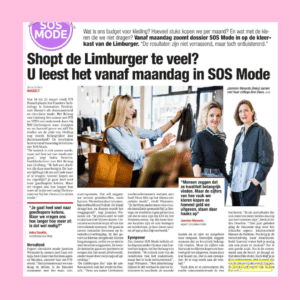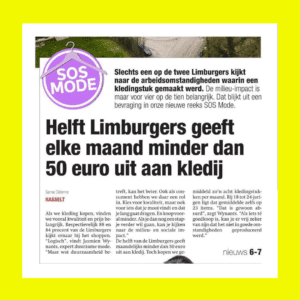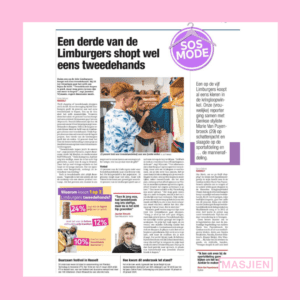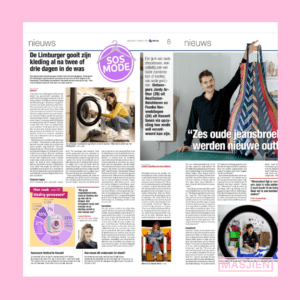SOS Mode Het Belang Van Limburg
Het Belang van Limburg, together with FTI and Vito, had a survey conducted among 500 Limburgers: where do we shop and how much do we spend? And do we still consider the price of clothing more important than sustainability?
Price and quality.
The Limburgers were surveyed on their priorities when shopping, revealing key insights into their preferences.
- 88% of respondents emphasized the significance of quality.
- Following closely behind, 84% identified price as a crucial factor in their purchasing decisions. Sustainability is less important to the 500 shoppers. Only half of Limburgers consider the working conditions under which garments are produced, indicating room for increased awareness and ethical consumption practices. Environmental impact ranked high for four in ten respondents, the manufacturing location held importance for three out of ten shoppers.
It is normal to think about price and quality when we shop. When it comes to sustainability, things can be better. Although I think we are already doing better than ten years ago.
During an interview with Het Belang Van Limburg Jasmien shared she often hears ‘Jasmien, I want to buy more sustainable clothes, but it is just too expensive.’ This survey found that half of Limburgers spend less than 50 euros on clothing every month. Yet they buy a lot of clothes for that amount. More than 23 (!) pieces in total every month to be exact.
This is just absurd. And that while 88% find quality the most important factor? Masjien would like to know how you can buy 23 pieces of clothing with 50 euros and still find quality important.
Here’s something to think about: someone who buys 1 T-shirt at Primark every six months because they can’t afford anything else is not the problem. But someone who leaves the shop with five bags every week or every month is. Because the latter does actually have the purchasing power to make different choices and that is precisely where the problem lies.
It’s the conspicuous consumption habits of those with greater purchasing power that contribute significantly to the issue. Ultimately, making sustainable choices doesn’t have to break the bank—as long as one exercises moderation and considers the true value of their purchases.
After all, sustainability isn’t just about the price tag; it’s about making thoughtful decisions that prioritize both quality and responsibility.
So no, making a sustainable choice does not need to cost you hundreds of euros…
as long als you don’t buy 23 pieces 😉
The most important thing in this story is that we invest in quality, see the value and not be so careless with it. On the one hand, people say that they find quality important. But the figures for how often we buy clothes and how much money we spend are somewhat at odds with this. That’s an eye opener. There is still a lot of work to be done.
This research was carried out in collaboration with Flanders Technology & Innovation (FTI). From March 16 to 21, 2024, FTI will be in Hasselt for a festival on sustainable prosperity with more than 100 initiatives. Check ftihasselt.be for all information.




Online shopping and the longevity of clothes.
Most Limburgers expect clothing to last a maximum of three years. Our feeling is that three years is not that long. How long clothing must last to be sustainable depends on the garment itself, but due to the current fashion system, we are used to seasons and trends and wanting new clothes, which is actually absurd. In the past, clothes were made to measure, and they were handled with care. It was seen as something valuable. Our grandparents handle clothes very differently, even today. Because they did not grow up in the fast fashion system, where clothes are so cheap.
Limburgers often buy these clothes from large multinationals: 30 percent do this at least once a month and that is a lot. If you buy at such a fast pace, you are buying things that by definition you don’t need. Due to the low prices you don’t really think about if you actually need that piece. If you buy clothing from a large fast fashion chain, you support a business model that pushes overconsumption through low prices. That cannot be sustainable. If you buy from a small designer, you support them and their craft. Every cent you spend counts.
But where do people buy these clothes? The younger, the more people shop online. 3 in 10 buy something online every month. More than half of 18-24 year olds shop online at least once a week. People often order many colors and sizes online, then try them on and return them. What many people don’t know is that a large part of what we return is no longer sold, but is destroyed. One in three is destroyed. That is a gigantic impact that we do not think about. That also makes online shopping less sustainable.
So: don’t turn your living room into a fitting room.
With the arrival of web shops such as Shein, fast fashion has evolved into even faster ultra-fast fashion. It’s sad to see that a t-shirt is sometimes cheaper than a sandwich and unfortunately that is also how a lot of people consume it.

